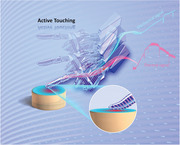- Record: found
- Abstract: found
- Article: found
4D Printing Strain Self‐Sensing and Temperature Self‐Sensing Integrated Sensor–Actuator with Bioinspired Gradient Gaps

Read this article at
Abstract
Integrated sensor–actuators with exciting functionalities, such as action self‐sensing, position self‐sensing, posture self‐sensing, or active sensing, are promising for applications in biomedical device, human–machine interaction, intelligent self‐protection devices, and humanoid robots. Despite recent progress, it remains challenging to achieve a macroscopical integrated sensor–actuator in a material system with microstructures. To address this critical challenge, a 4D printing bioinspired microstructure strategy is reported to design a high‐performance integrated sensor–actuator capable of simultaneous actuation and sensation. Decoupled thermal stimulation and strain sensation is achieved by combining nanocarbon black/polylactic acid composites with bioinspired gradient microgap structures. As a result, printed integrated sensor–actuators can actively touch objects triggered by thermal stimulation and self‐sense the touching state through the resistance change. It is anticipated that the basic design principle underlying this behavior can be used to develop integrated sensor–actuators of various shapes and functionalities to meet desirable applications.
Abstract
A printable integrated sensor–actuator (PISA) with bioinspired gradient gaps is reported. Using 4D printing, the bionic structure is creatively combined with smart materials to obtain the sensor–actuator components with self‐temperature sensing and active touching strain feedback. This PISA and its design principle provide a promising approach to fabricate smart devices in future humanoid system.
